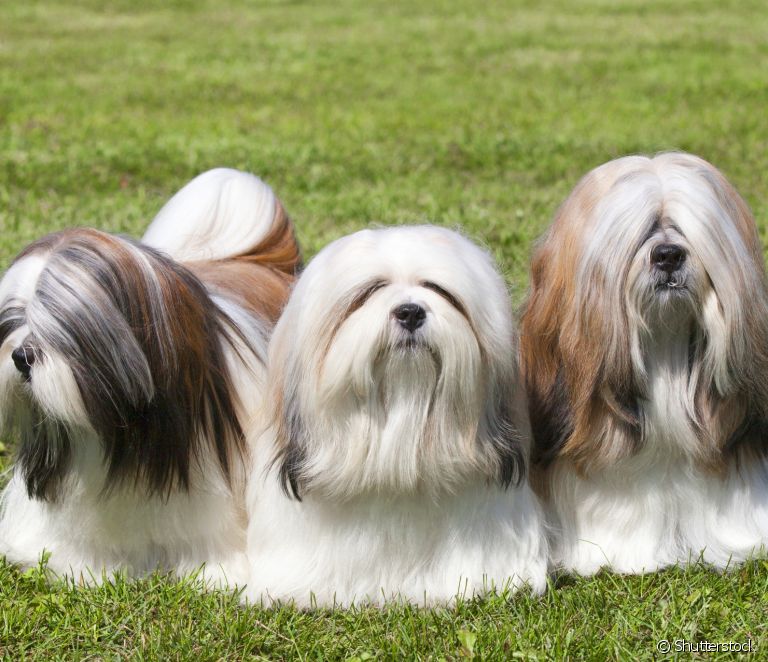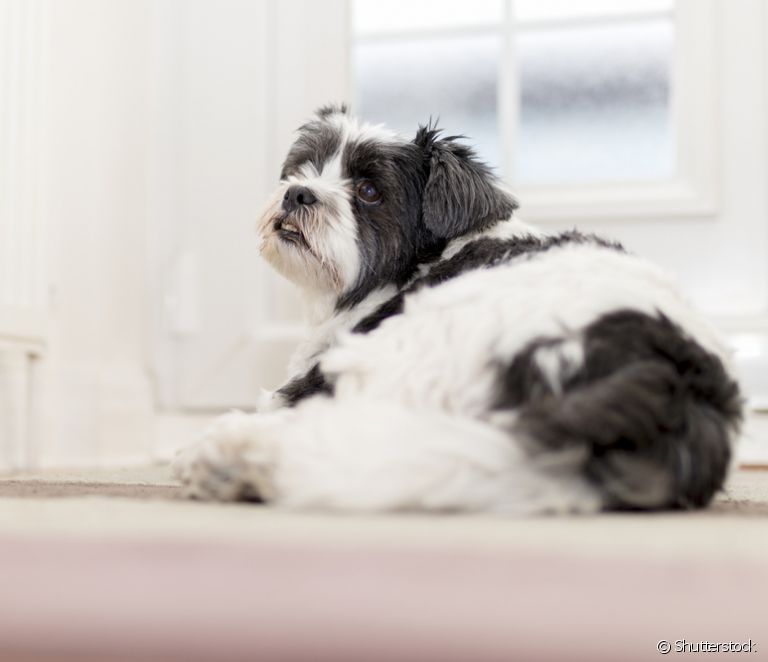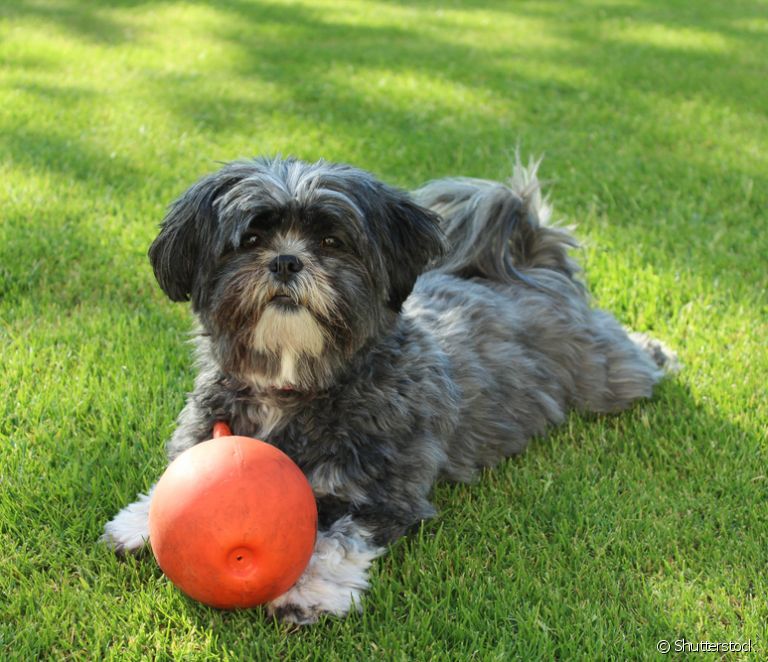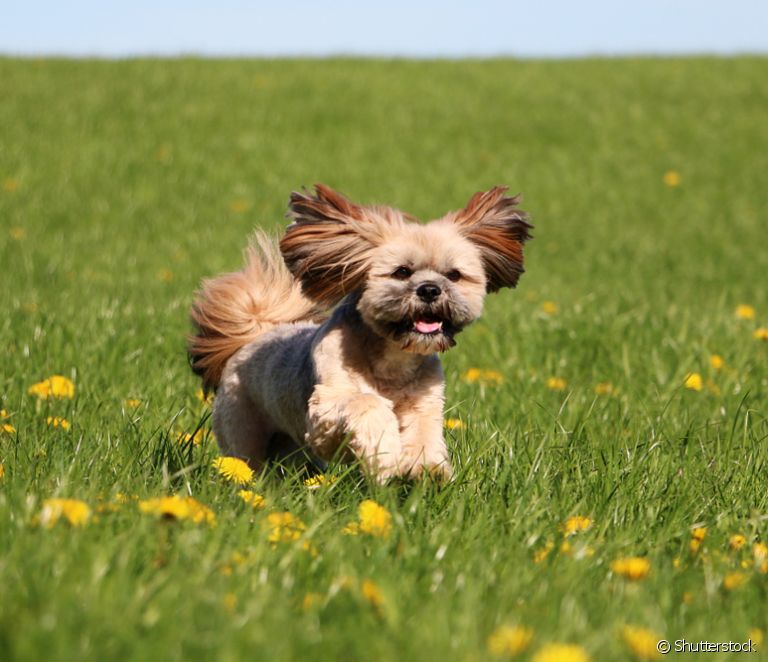Lhasa Apso: learn all about the breed

Table of contents
If you're a pet lover, you've surely heard about the Lhasa Apso dog breed, since it's super popular. Even though this little dog is known around, many people still confuse the Lhasa Apso with the Shih Tzu, but the two small dogs only have similarities in appearance. Full of energy, passionate about playing and with the protective instinct of a German Shepherd, the dogLhasa Apso is a great companion dog and one of the most suitable breeds to live with children and the elderly. Do you want to know more about him? We have gathered information about his origin, personality, physical characteristics, price, training tips and care that this little dog needs. Take a look below and find out everything about Lhasa Apso!
What is the origin of the Lhasa dog breed?
The Lhasa Apso breed is considered one of the oldest in the world. This little dog had its origin in Tibet, where for many years the furry one was a companion of Buddhist monks and nobles. The name Lhasa Apso has two derivations. Lhasa is also the name of the capital of Tibet, while Apso is the name of a goat in the region that has a coat very similar to that of the little dog. It is estimated that the Lhasa dog appearedThe breed also became popular in Great Britain and in 1935 was accepted into the American Kennel Club (AKC).
Lhasa dog breed: protective personality in small size
At first glance, the Lhasa Apso dogs are extremely cute and the kind that everyone wants to squeeze and pet (especially when we talk about the Lhasa Apso puppy). But in fact, the Lhasa Apso is a guard dog that was born a little smaller than the other animals that play this role: constantly attentive to everything that is happening to its owner.around, the Lhasa is very protective and will always signal with barks any sign of danger near the owner, since it is super attached to the tutor.
His protective instinct and strong personality make him suspicious of strangers at first, but once he gets used to them he is always docile and playful. Socializing a puppy from the puppy stage is very important so that he does not give trouble to visitors and strangers when he is an adult. With children, the rhythm is the same: when socialized and after gaining confidencewith company, the Lhasa breed's relationship with them is amazing.
Because it is small and very quiet, the Lhasa Apso is considered a great dog for apartments. Ideally, just like any other breed of dog, it should have a specific corner to eat, drink water and rest and another to pee and poop. The Lhasa dog barking a lot can be a problem with the neighbors in the case of apartments, but positive training usually improves itEven if he is small and probably won't feel trapped or with little space to move around, the ideal is for you to walk your Lhasa Apso once a day. Also, if he spends long periods alone at home, however independent and calm he may be, the Lhasa Apso will need attention and affection (but everything with limits: the Lhasa is not a big fan of cuddlingexcessive).
The physical characteristics of the Lhasa Apso dog breed
The long and dense coat is one of the main characteristics of the Lhasa Apso at all stages of life. The breed usually has hair in shades of white and gold, but can also have darker nuances, such as black and gray Lhasa. Other shades such as sand and honey are also observed in some dogs, in addition to mixed tones, such as black and white Lhasa Apso. All the charm of the coat is aligned with the characteristics of the breed.The Lhasa is a small dog with a height ranging from 15 cm to 25 cm, weighing from 5 kg to 7 kg.



Lhasa: dog needs routine care
1) Coat of the Lhasa Apso
As mentioned above, one of the greatest charms of this breed is its long coat. The hair can have multiple shades, but whether the Lhasa Apso is black or any other color, care is super important. Keeping the Lhasa Apso clipped (especially in the head region) helps to make the dog more comfortable, since the rapid growth of hair can hinder vision - the tutor canchoose between hygienic, Japanese and summer heat relief shampoos. Another essential care for this pet's coat is daily brushing: the Lhasa's long hair makes it easy for knots to form on the body.
2) Bathing the Lhasa puppy
Because of the large amount of hair, you also need to be aware of possible dermatitis and allergies on the animal's skin, as they can happen and remain hidden. Precisely because of the large amount of hair, the ideal is for the Lhasa Apso to be bathed weekly or, at most, every 15 days. Make sure it is very dry after baths and be very careful with fleas and allergies.ticks - keeping your pet's wormers up to date can be a great way to avoid the problem.
3) Lhasa Apso nails, teeth and ears
The nails also deserve special attention from the tutor. If they get too big they can affect the pet's well-being, causing discomfort when walking. Because of this, they should be trimmed whenever necessary. The most experienced tutors already know how to cut dog nails at home, however if you still feel insecure about it, it is worth looking for a professionalAnother important care for the Lhasa dog is oral hygiene: your pet's teeth should be brushed at least three times a week to avoid bad breath and tartar build-up. Last but not least, make sure to keep the Lhasa's ears clean and dry, as the drooping ears and large amount of hair favor the accumulation of fungi in the area. Byso clean with pet-specific products at least once a week.
4) Walking the Lhasa dog
Even though the puppy Lhasa Apso has a lot of energy and loves to play - especially with his favorite guardian - when the adult Lhasa Apso wants to rest, it is good that his time is respected. He needs daily walks for health maintenance, but there is no need for heavy or very long runs as often as other dog breeds ask for. The Lhasa doespart of the brachycephalic breeds, which have a slightly flatter muzzle than normal - so they don't even have the breath for the heaviest activities. Interactive toys can help burn off your dog's energy and keep boredom at bay.
See_also: Antiallergic for dogs: is the use of the drug safe and effective?Training the Lhasa Apso dog is a task that requires persistence from the tutor
Socialization, which is super important for the Lhasa Apso puppy to grow up living well with other people and animals, is usually accompanied by training. The Lhasa breed is not one of those that memorize commands so easily, because they are more distracted and, in a way, even a little lazy. But at the same time, the desire to please the owner and make him stay with the dog is very important.happy is a great reason for the Lhasa to overcome stubbornness and obey the guardian. He will need more repetitions and daily training to memorize all the commands. Positive training is ideal for holding the Lhasa's attention. Treats, celebration and praise are great rewards to give the Lhasa dog every time he gets something right that the guardian asks for.
Dog breeds: Lhasa Apso is a little dog surrounded by curiosities
- The Lhasa Apso also has many curiosities linked to its origin. In Tibet, the dogs of the breed were considered sacred and only the monks or the nobles of the region had them as pets.
- Lhasa dogs were the guardians of temples and it was believed that when the guardian of a Lhasa Apso died, his soul went through a reincarnation process, moving into the dog's body.
- The Lhasa was considered a good luck charm and could only leave Tibetan territory if given as a gift.
- Another very interesting curiosity about the breed is that it is present in comic books. Floquinho, Cebolinha's dog, character from Turma da Mônica, is a Lhasa. The amount of hair of the character is typical of the breed and represents this dog very well.



Lhasa Apso x Shih Tzu: breeds often confused
Two brachycephalic and small dog breeds: in general, these are the two main similarities between the Lhasa Apso and the Shih Tzu, but still, many people confuse the animals of these breeds. To begin with, the physical differences: the Lhasa Apso dog is usually a little bigger than the Shih Tzu, weighing up to three kilos more. While the Shih Tzu has very rounded eyes andThe Lhasa has a flattened muzzle, a more oval look and a slightly elongated nose. The coat is also different, as the Lhasa's coat is thicker and heavier - so much so that, if not cut, it can reach the ground.
See_also: Cat bladder: everything you need to know about the lower urinary tract of felinesPersonality-wise, the Lhasa Apso can be a bit more territorial if not socialized properly, as its watchdog instinct makes it more wary and alert than the other breed. The Lhasa is also stubborn and independent, unlike the Shih Tzu. The Lhasa can bark more and has a more independent side, and may even spend some periods alone at home.
Lhasa Apso puppy: price varies between R$ 2,000 and R$ 4,500
After so much information, there is one question that should be on your mind about the Lhasa Apso: breed price. The average cost to buy a Lhasa Apso varies between R $ 2,000 and R $ 4,500. All the characteristics of the genetic lineage can interfere with the price of the Lhasa Apso: the value can be more expensive if the puppy has parents who are championship winners, for example. It is also worth mentioningthat the arrival of a dog at home also requires a lot of costs for care, animal food, checkups at the vet, etc. First of all, it is very worthwhile to plan the arrival of your puppy at home and assess the situation so as not to make any hasty decisions.
But when it comes to the Lhasa Apso, value should not be the main factor of choice. Be wary of very low prices and breeders who do not accept visits or answer all your questions. Search for Lhasa Apso kennels that have certification and good references so as not to finance mistreatment.
All about Lhasa Apso: breed x-ray!
- Life expectancy: 15 years
- Average height: 15 to 25 cm
- Average weight: 5 to 7 kg
- Type of coat: long
- Colors of the Lhasa: white, gold, black, sand, honey and grey - both in one color and with streaks across the body.
- Lhasa Apso price: R$ 2,000 to R$ 4,500

